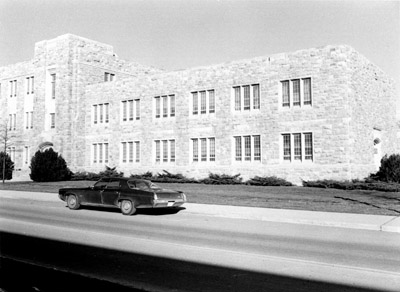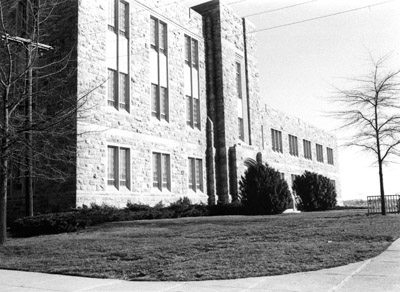History

A short history of the creation of the Department of Biochemistry and Nutrition at Virginia Tech covering only the years from 1952-62.
Prepared by Prof. Emeritus George Edwin Bunce
VPI BS in Forestry 1954
VPI MS in Biochemistry and Nutrition 1956
Univ. of Wisconsin PhD 1961
Professor Virginia Tech 1965-95

"In 1952, the Dean of Agriculture, Harold Young, decided to expand the program in Agricultural Chemistry at VPI to create a Department of Biochemistry and Nutrition that would carry out both basic and applied research in these fields and offer MS and Ph.D. degrees. After a search, Dr. Reuben W. (Charlie) Engel who was at Auburn University at that time, was offered the position and accepted.
Dr. Engel was born and raised on a dairy farm in Wisconsin, obtained a BS in Chemistry from the University of Wisconsin, and was accepted into the Wisconsin Medical School. During his first year, he attended a seminar by a faculty member in the Department of Biochemistry (located in the College of Agriculture) on the importance of trace minerals in health and disease. He decided that he would transfer from medical school and instead pursue a PhD. in Biochemistry under the guidance of Professor Paul Phillips.
During WWII, Dr. Engel served as an officer in the US Army Medical Service Corps. His principal duty was oversight of the nutritional rehabilitation of prisoners liberated from POW camps in the Philippines. Here he saw firsthand the ravages of malnutrition in human populations.
Arriving at VPI (the name at that time), he was given an office and some laboratory space in Smyth Hall and began to assemble a faculty. Lacking a dedicated building, he created joint appointments in Biology and in other Departments in the College of Agriculture. Drs. Kendall King and W.E.C (Ed) Moore from Biology were housed in Price Hall. They entered into a collaboration in which Moore began isolating and identifying the microorganisms in the bovine rumen and King initiated studies on the mechanisms of the cellulase enzyme complex that digested plant fibers in the rumen. King became a world leader in unraveling the actions of the cellulase complex and Moore eventually established the Anaerobe Lab that was internationally recognized for the development of techniques to raise these organisms and to investigate their role in both health and disease. Dr. Everett (Chick) Wisman (a WW II Inf. officer in Europe) held a joint appointment in Biochemistry and Poultry Science and Dr. Don Cochran was joint between Biochemistry and Entomology. Ass't Prof. Roddy Young used facilities in Smyth Hall to create a Pesticide Analysis Lab. Dr. Clem Ackerman (Clemson) was hired to his first academic position to study the role of ethylene oxide in the ripening of fruit. Dr. Dan Lane was hired for his first faculty position at the University of Illinois. He went on to be highly regarded for his discoveries (both at VPI and later at Johns Hopkins University) on biotin metabolism and on the biochemistry of insulin and diabetes.
Engel gave up his own research program in order to build the department. However, he and Dr. Wilson Bell (DVM) were asked to visit the dairy farm owned by a wealthy engineer, Mr. Pratt, the co-inventor of the Pratt and Whitney engine. His cattle were not thriving and he wanted the state Agriculture College to provide him with an answer. Engel and Bell took forage and soil samples back to Blacksburg where they soon discovered that they were low in trace minerals. The provision of trace mineral salt blocks solved the problem and the cattle began to thrive. Mr. Pratt was very impressed with Engel and subsequently made a significant grant to the Department to be dispensed as Engel saw fit.
At about the same time, a new disease began to appear in cattle in various sites in Virginia and other states. The animals developed severe hyperkeratosis and lesions around their eyes that resembled vitamin A deficiency. Eventually, they would become emaciated and die. The cause of this condition was unknown and it was christened X-disease. Again Engel and Bell rose to the challenge. They suspected a contaminant in the food pellets. Further investigation revealed that an additive (hexachloronaphthalene) to the lubricants used on tractors and on food pelleting lines was the toxic agent. Removal of this additive resolved the problem. (I was an MS degree student in the Dept from 1954-56 studying the effect of HCN on carotene conversion to vitamin A).
But, in order to have a thriving department, it was necessary to develop a dedicated building. Dr. Engel prepared a grant for 50% of the cost of a three-story L-shaped building and submitted it to the Federal Government. It was approved and the state of Virginia matched it dollar for dollar. (Those were the days!) The building was completed in 1962.
Dr. Engel and Dr. King also became prominent in the field of human nutrition in the Global South. They developed and installed in Haiti a program called the Mothercraft Center. In villages in Haiti, the diets of the children consisted primarily of beans or grains. Neither of these foods contained a balanced ratio of essential amino acids and growth was stunted. If consumed at the same time, however, the blend would be complementary in amino acid content and permit better growth. They developed recipes that mixed these foods and then enlisted mothers into a program where these recipes were fed to their children. Proof of the benefits of these mixtures was presented to the mothers by observing the enhanced weight gains of their children. These simple data points persuaded them of the value of the recipes. After Dr. Engel stepped down from the headship in 1967, he obtained a grant from the USAID to introduce this program in the Philippines. He relocated to Manila as the "on-site" VPI advisor where in collaboration with the local government, the Mothercraft program was installed. A federal review named this as the most successful intervention program in Asia of the Agency for International Development. For these contributions, Engel received the Elvehjem Award for Public Service in Nutrition awarded by the American Institute of Nutrition.
In 1989, Dr. Thomas Keenan, the Department Head at that time, presented a proposal to the Board of Visitors that this building should bear Dr. Engel's name in recognition of his achievements in establishing the Department and in raising the funds for its construction and this proposal was unanimously approved. The official ceremony took place on May 19 of that year. Dr. Engel attended and many of his former faculty and students were able to celebrate this day with him. Dr. Lane gave the main address and praised Engel for his mentorship and leadership.
These are the origins of the current Department of Biochemistry at Virginia Tech. Today the current faculty are engaged in cutting-edge research on a wide array of biochemical topics. The present knowledge and techniques could not have been imagined in 1950-60 when the seminal paper on DNA structure by Watson and Crick was published (1953). Today DNA sequences are analyzed with stunning rapidity and accuracy. The protein structure is presented in molecular detail. One can only wonder what new knowledge we will have in another sixty years."
For additional historical information, please click here.



Presented by the University Archives of the University Libraries with the Department of Biochemistry of Virginia Tech.


